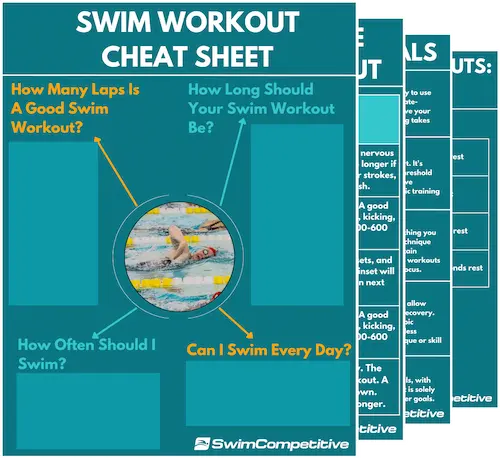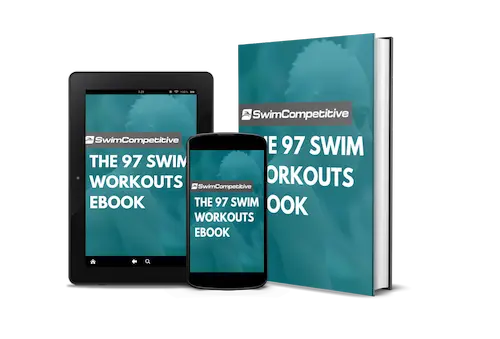For a lot of swimmers, raw speed is the ultimate goal, but for many others, it is being able to cover long distances, whether open water or in the pool. For this type of swimming, we require slightly different swimming technique in order to ensure maximum efficiency in the water.
And that’s why in today’s article, we’ll be taking a look at long distance swimming technique and how you can perfect it to become a better long distance swimmer.
The chosen stroke for long-distance swimming is freestyle, also known as front crawl since it is the most energy-efficient and fastest stroke to use over long distances, which is our main goal here.
The majority of long-distance swims take place in open water events, with distances ranging from 1km all the way to 25km in length. In competitive pool swimming, there are also long distance events, with the most common being the 800m and 1500m freestyle events.
In truth, there are slight differences between open water and pool distance swimming technique, but they are also very similar, and today we’ll be covering the most important long distance swimming technique aspects for both so that you can maximize your efficiency and performance regardless of where you swim.
That said, if you are a recreational swimmer, simply looking to dish out a lot of distance in the pool to get a good swimming workout, then these points can also help you get it done in a more professional and effective way.
So without further delay, let’s get started-
Perfect Your Long-Distance Swimming Technique. Here’s How-
Correct long distance swimming technique:
- Use round arm freestyle when swimming long distance.
- Maintain correct body position and use long strokes.
- Keep a high elbow position when swimming.
- Use a two-beat kick for long-distance swimming.
- Learn correct breathing technique.
- Maintain a neutral head position.
- Keep fingers slightly open and hands cupped.
1. The Perfect Balance Between Speed and Endurance: Round Arm Freestyle
In freestyle swimming, there are 3 main types of arm technique that you can use, for distance swimming round arm is the most effective style. Let’s have a look at each arm style to give you a better understanding-
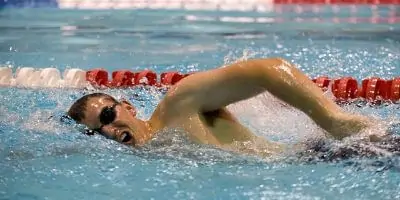
Bent arm freestyle: This is the oldest style of freestyle arm technique, and has in many ways become a less superior and outdated way of swimming. It involves keeping your arm bent in an angle-like position during the recovery portion of the stroke.
Back in the day, this was a very popular way of swimming, but with the immersion of straight- and round-arm freestyle, it has mostly disappeared. I don’t recommend swimming like this as it places the shoulder most at risk for injury and isn’t the most efficient way of swimming.
Straight arm freestyle: Straight arm freestyle is the fastest and most powerful way of swimming freestyle. This arm style is used by sprint freestyle swimmers in competitive events like the 50m and 100m freestyle.
And although it is the fastest, it isn’t the most energy-efficient seeing as this stroke is focused on power and speed. I only recommend this style of swimming for swimmers who are focused on the events mentioned above, namely 50m and 100m freestyle sprints.
Round arm freestyle: This brings us to the last style of freestyle arm technique, namely round arm freestyle. This is going to be the style that you should use for long distance swimming. It is good to use as it is right in the middle between bent- and straight arm freestyle and is the perfect balance between speed and endurance. This style of freestyle can be used for both sprinting and long distance swimming, which is why it’s so great.
How to perform round arm freestyle:
As the name suggests with this arm style the idea is to form a round position with your arm. The easiest way to do this is by visualizing your arm being wrapped around the top of an exercise ball or round barrel.
You can also physically place your arm around one to get a feel for the position that your arm should be in.
When swimming with this style, you want to stretch out so that you feel a stretch in your lat after your hand has entered the water. This should make your arm go into a straight position under the water, which is the same for all of the arm styles.
Then you want to pull back on the water, make sure that your arms never move directly underneath your body as this will reduce propulsion and increase resistance, but we’ll discuss this a bit more later.
Related: Weight training for distance swimmers- 8 best exercises.
2. Ensure Energy Efficiency: Maintain Correct Body Position and a Long Stroke
Maintaining a long stroke is an important part of efficient long distance swimming technique. Short arm pulls provide less propulsion with higher energy usage which isn’t exactly ideal for long-distance swimming, where energy-efficiency is a crucial aspect.
To achieve long and efficient strokes we should start with our body position, another highly important part of efficient swimming.
The proper freestyle body position is to maintain a flat and horizontal position in the water at all times. Don’t allow your legs to drop below your hips or your body to bend at the hips as this will compromise your body position and increase drag and energy consumption.
Once your body is correctly positioned in the water, we can focus on a long stroke. For this we want to reach as far forward as possible, usually, you should feel a nice stretch running across your lat from the shoulder blade.
Mistake: a common mistake made by swimmers when trying to swim with long strokes is that they’ll stretch out during the recovery portion of the stroke when the arm is still above the water.
You want your hand to first enter the water at a slightly angled position and then you want to stretch forward under the water so that your arm straightens out.
These 2 aspects (stretching arms while maintaining a flat and horizontal body position) creates the basic mechanism which will efficiently propel you forward in the water, allowing you to save energy for your long-distance swim.
Watch this short video for a more visual explanation of the correct freestyle body position-
3. Maximize Pulling Propulsion: Keep a High Elbow Position
Swimming with a high elbow position is a critical part of maximizing your propulsion in the most efficient manner. Something to note here is that I’m talking about the elbow position under the water, not above.
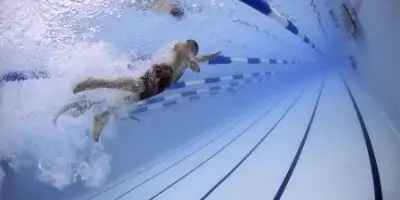
To achieve this you want to keep the elbow high in the water during the beginning portion of the arms stroke, after that, you want to create a slight bend and bring it outward so that your forearm moves into a vertical position.
Once your forearm and palm are facing backward, you can push back to create the maximum amount of propulsion in the most efficient way possible. This, combined with a long arm stroke and good body position, will ensure that you can swim fast without using much energy.
Why is this the most efficient way to swim long-distance freestyle? The deeper you pull, the more the water pressure. This means you can swim faster, but it’ll use much more energy compared to a more shallow (high elbow) pull).
Related: Endurance swimming workouts for distance swimmers.
Do You Want to Make Every Lap Count?
Stop wasting your time in the pool feeling lost and doing directionless swim workouts, and start training effectively! Our ebook contains 97 structured and goal-orientated swim workouts to help you become a better, faster, and fitter swimmer. Whether you’re a complete beginner or a seasoned pro, there are a multitude of workouts for every type of swimmer.
4. Your Motor: Utilize a Two-Beat Kick
The legs serve as a key component of swimming long distances. They should be working non-stop and in doing so will create a type of motor powering you from behind and assisting with your arms strokes at all times.
By utilizing a two-beat kick you’ll be saving energy and breathing will also be easier, allowing you to be more relaxed in the water, which is very important for long-distance swimming.
To perform a two-beat kick you want to kick once during the entire stroke cycle, allowing for a total of 2 kicks. This essentially means that your arms and kicks will be executed in the same rhythm.
To better explain it, let me give you another example. Say you were using a 4 beat kick. Then you would have to kick twice with each leg during the stroke cycle for a total of 4 kicks. This means your kicking will be faster than your arms.
Consider watching this short video for a more visual explanation-
5. Proper Breathing Is Key: 3 Critical Points
Oxygen is required for muscles to function at peak levels. Take it away? Fatigue increases, performance drops, and you swim slower. That’s why breathing is an important aspect of long distance swimming technique. We want to maintain a deep and relaxed breathing style at all times.
Exhale under the water: to ensure the most efficient breathing, make sure to exhale under the water, as holding onto used air won’t benefit you much. This will allow you to fill your lungs much faster as you come up to take a breath which will allow you to place your head back into a neutral position to ensure optimal body position.
It will also help you to take in more oxygen as you’ll most likely be able to pull in more air since you won’t have to first blow and then inhale. You simply have to tilt your head to the side and inhale.
Breathe once per arm cycle: an arm cycle consists of 2 full strokes. In competitive swimming, it is common to use limiting breathing patterns during shorter swims or not to breathe at all on sprints like the 50m as this ultimately increases speed.
This, however, only works for a small period of time and isn’t ideal for distance swimming. For long-distance swimming, you want to breathe once per arm cycle to ensure that oxygen levels stay high at all times, which will optimize performance and reduce fatigue over the course of your swim.
One-sided breathing: This is the correct way to swim, regardless of whether you’re swimming long distance or not. Using a one-sided breathing pattern allows for good rhythm and optimal flow of oxygen as you swim.
Related: Breathing Exercises For Swimmers To Improve Lung Capacity And Performance.
6. Maintaining a Good Stroke: Neutral Head Position
Keeping a neutral head position throughout your swim is a highly important part of ensuring that your body position stays correct and that you don’t create any unnecessary drag while swimming.
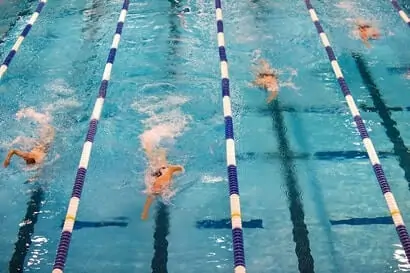
When swimming, many people tend to look forward rather than down. This can cause your legs and hips to sink which will compromise the flat and horizontal body position we talked about earlier.
This can result in you having to kick harder, which will use more energy, as well as placing strain on your neck, which isn’t really something you want to do when swimming long distances.
To prevent this you should aim to keep your head in line with your body, to do this look directly down towards the floor of the pool or lake that you’re swimming in.
Note: I know for open water swimming, you have to look up every now and then to ensure proper direction. This is fine as it is required, but try to hold a neutral head position the rest of the time.
7. Get a Good Grip in the Water: the Hand and Finger Position
Over the years there has been a lot of debate about the right finger position when swimming. Should your fingers be open or closed when pulling? What do you think?
Well, as a consequence many studies have been done on this topic, with the majority of results leaning towards using an open finger position. The idea is that it will allow your fingers to wiggle around which will cover more surface area and in return allow you to swim with higher propulsion.
If we take a look at a study published by the Human Kinetics Journal [1] it is, in fact, clear that this is the case. This study, along with many others, suggests that propulsion is enhanced by a small finger spread while swimming.
For optimal grip and propulsion through your hands, push your thumb slightly out and down and allow for small gaps between your fingers. This will create a cupped position that will be most effective for propelling you forward in the water.
In terms of the hand position, you want to keep your hand slightly angled when entering the water, and then allow it to flatten out as you reach forward to take that long stroke we discussed earlier.
Related: How to improve swimming endurance.
Perfecting Your Long Distance Swimming Technique Takes Time
Long-distance swimming may sound boring to some but it can be a lot of fun and involves just as many technical aspects as standard pool competition swimming. I recommend all swimmers to do some form of long distance swim at one point or another during their swimming career.
Personally, I’ve only done a few open water swims, but they are always quite fun and thrilling to complete. So with that said, I hope this article helped you to perfect your long distance swimming technique so that you can conquer your next swim.
